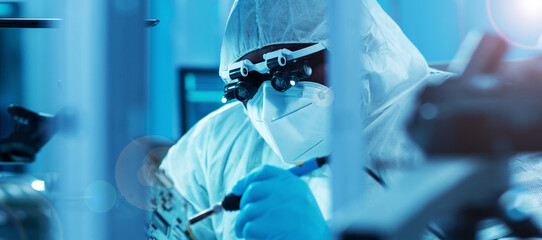There are two general instruments to measure fluorescence, which are fluorometers and spectrofluorometers, in this article we will focus on the differences between both equipment.
Fluorescence can be defined as a type of luminescence that occurs in gaseous, liquid or solid substances that are capable of absorbing electromagnetic radiation (for example, light), and emitting part of that energy as radiation of a wavelength other than the absorbed.
What is a fluorometer?
A fluorometer is an instrument that uses optical filters to isolate incident light and fluorescent light, and measures the sample’s ability to absorb light at one wavelength and emit light at a longer wavelength.
In these devices, a radiation source (luminous) emits light of an excitation wavelength for the compound to be measured or analyzed. The excitation of the compound to be analyzed is produced through the use of optical filters, these work by blocking other wavelengths and transmitting the appropriate wavelength to produce excitation of the compound. The light generated by the radiation source passes through the sample to be measured, and a certain amount of wavelength is absorbed, while it is then emitted at a longer wavelength. This emitted light is measured by a detector.
Fluorometers are highly sensitive, and the optical filters used by them are generally inexpensive and easy to change. This makes fluorometers widely used equipment in scientific and experimental research, and for academic purposes.
What is a spectrofluorometer?
Spectrofluorometers are equipment used to analyze the fluorescence of a sample. They employ diffraction grating monochromators to isolate incident light and fluorescent light. They typically use excitation monochoromators, which include a wavelength scatterer, and an emission monochromator.
These equipments have four main components: a radiation source (Xenon lamp or a laser), an excitation monochromator (responsible for selecting the appropriate wavelength for the excitation of the sample), an emission monochromator (who analyzes the emissions produced by the fluorescence emitted by the sample) and a photodetector which receives the light waves and transforms them into a measurable unit proportional to the intensity of the light received.
Among the advantages of a spectrofluorometer is that they allow a variable wavelength to be selected, but they are much more expensive than fluorometers and can only provide moderate sensitivity and specificity.
Spectrofluorometers are used in reaction kinetics research, photochemical research in biological systems, water quality, wine quality control, luminescence and photoluminescence studies.
At Kalstein we are MANUFACTURERS of medical equipment of the highest quality and innovative technology, that is why we offer you excellent fluorometers and spectrofluorometers, at the best PRICES on the market. That’s why we invite you to take a look HERE




